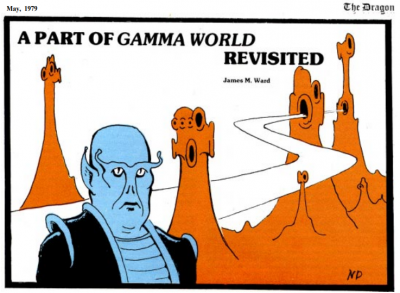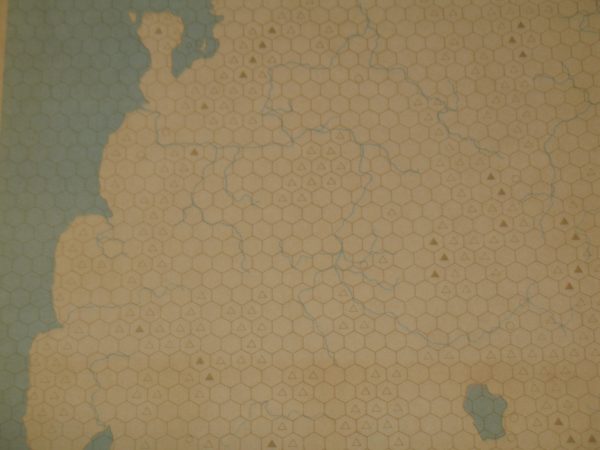 First edition Gamma World contains an intriguing hex map of post-apocalyptic America. It’s charming, but it consists only of rivers, unshaded triangle mountains, dark triangle mountains, and circles representing former cities of the ancients. There is no key. And there are no instructions on how to use it except for one brief aside in the Example of Play section:
First edition Gamma World contains an intriguing hex map of post-apocalyptic America. It’s charming, but it consists only of rivers, unshaded triangle mountains, dark triangle mountains, and circles representing former cities of the ancients. There is no key. And there are no instructions on how to use it except for one brief aside in the Example of Play section:
The first step is to choose an area of the country from the map provided. The referee can either mark directly on the map or transfer the geographical features to blank hex paper and enlarge the scale. The second method allows the referee to add more detail, such as ruins, towns, villages, farmlands, special points of interest, and so on.
There is precious little to go on here. Three years later the classic Marsh/Cook Expert D&D set would introduce an entire generation to a worked example of how open-ended wilderness adventuring could actually work… but that sort of introductory product was nigh unto inconceivable at this point. Meanwhile, the third edition Gamma World set from the mid-eighties would include a variety of maps at varying degrees of resolution… but alas, it was bereft of any keys or commentary on how they would actually work!
Needless to say, this is more than a little confusing– especially since the entire genre this line is predicated on has pretty well ceased to exist. But now that I’ve played the original games for a few sessions, a few things about this map come clearer. Basically, if you’re looking at this game with preconceptions you’re bringing in from D&D… you’re going to miss a great deal.
In the first place, this is Gamma WORLD. If you want to play in a dungeon, you can go back to the precursor game and play in a big old dungeon in space. It’s awesome. But Gamma World is different. And if you start placing lots of D&D style dungeons on the map, I think you’re going to miss the real point of the game.
Secondly, given that players start with mass quantities of hit points and several fairly powerful mutations, they can range much farther than low level D&D adventure parties. If the players can acquire mutant animal mounts and/or a modest amount of high tech equipment, they can range even farther! What this means is that you’re going to be able to leverage far more scope within a large scale campaign map like this than you might imagine. This odd campaign map appears strange at first glance, but it is actually a good fit for the rule set.
Still, this particular map never quite became the sort of icon of gaming that the Known World of Basic D&D’s default setting or later franchises such as the Forgotten Realms. Heck, the Starship Warden of Metamorphosis Alpha arguably made ten times the splash! What’s up with that?! Well, I believe that the real key to running a straight ahead Gamma World campaign was left out of the box set completely.
Fortunately, gaming archaeologists that can track down a copy of Dragon Magazine #25 and get the key they should have had way back in the seventies or eighties but which they (more than likely) had to do without. In a mere two pages, James Ward provides not only brief origin stories and chief NPCs for each of the cryptic alliances of the game, but also places their original home base on that utterly baffling campaign map that I could never figure out what to do with…!
Of course, now that my campaign is already underway, my own framing of the setting has departed significantly from the setupthat Ward provides in “A Part of Gamma World Revisited”. But creating your own variation of what he did there is probably the easiest method around for leveraging the game’s campaign map if you want to capture how the game was meant to be played at the beginning…!

-
Bryce, I owe you a round of drinks! I haven’t seen that Dragon magazine for decades, but I remember nearly every single page.